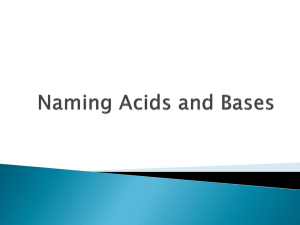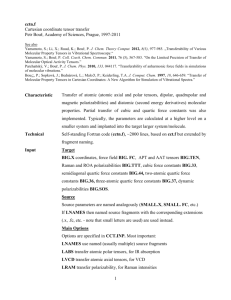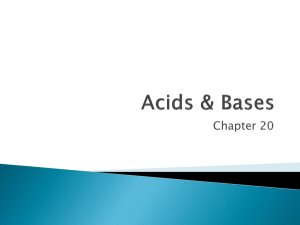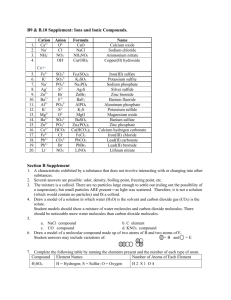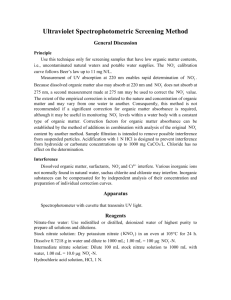Polarizability and Aqueous Solvation of Nitrate anion
advertisement
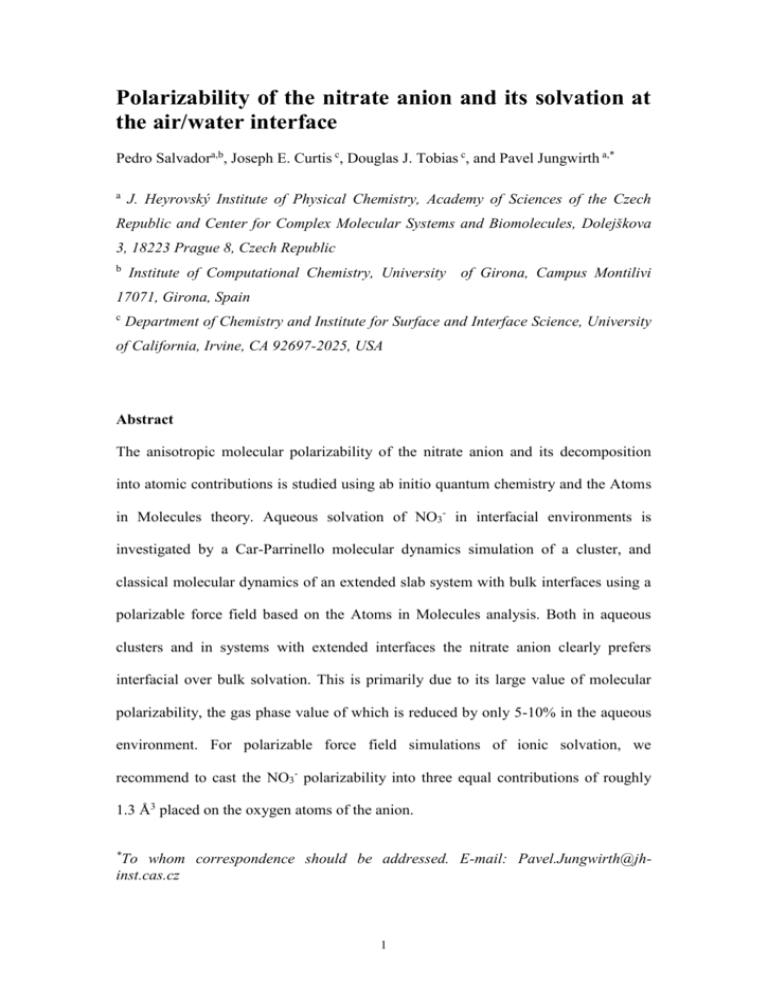
Polarizability of the nitrate anion and its solvation at the air/water interface Pedro Salvadora,b, Joseph E. Curtis c, Douglas J. Tobias c, and Pavel Jungwirth a,* a J. Heyrovský Institute of Physical Chemistry, Academy of Sciences of the Czech Republic and Center for Complex Molecular Systems and Biomolecules, Dolejškova 3, 18223 Prague 8, Czech Republic b Institute of Computational Chemistry, University of Girona, Campus Montilivi 17071, Girona, Spain c Department of Chemistry and Institute for Surface and Interface Science, University of California, Irvine, CA 92697-2025, USA Abstract The anisotropic molecular polarizability of the nitrate anion and its decomposition into atomic contributions is studied using ab initio quantum chemistry and the Atoms in Molecules theory. Aqueous solvation of NO3- in interfacial environments is investigated by a Car-Parrinello molecular dynamics simulation of a cluster, and classical molecular dynamics of an extended slab system with bulk interfaces using a polarizable force field based on the Atoms in Molecules analysis. Both in aqueous clusters and in systems with extended interfaces the nitrate anion clearly prefers interfacial over bulk solvation. This is primarily due to its large value of molecular polarizability, the gas phase value of which is reduced by only 5-10% in the aqueous environment. For polarizable force field simulations of ionic solvation, we recommend to cast the NO3- polarizability into three equal contributions of roughly 1.3 Å3 placed on the oxygen atoms of the anion. * To whom correspondence should be addressed. E-mail: Pavel.Jungwirth@jhinst.cas.cz 1 1. Introduction Nitrate anion belongs together with sulfate, bisulfate, and chloride to the most abundant ions in the atmosphere. It can be found in atmospheric aerosols both in the polluted and remote troposphere, and it plays an important role in many atmospheric chemical processes.1-2 It has been shown recently that the chemistry of these ions in aqueous aerosols can strongly depend on their location, either in the bulk or at the surface of the aerosol.3 Molecular dynamics (MD) simulations of halide ions in large aqueous clusters4-5 and in water slabs3 clearly showed that it is the value of the anionic polarizability which determines bulk vs. surface solvation. While hard, nonpolarizable ions such as fluoride solvate in the aqueous bulk, all the heavier halides, which have a large value of polarizability, are predicted to have a significant propensity for the extended air/water interface.3,6-9 As a matter of fact, bromide and iodide even behave as surfactants with a larger concentration at the surface than in the bulk.7 Since polarizability plays a crucial role in aqueous solvations, we attempted to determine accurately its value for two prominent atmospheric anions – chloride10 and sulfate.11 We used a combination of ab initio quantum chemistry calculations, and Car-Parrinello and classical MD simulations in order to establish the solvent effect on the ionic polarizability. In the case of Cl- we showed that water environment significantly reduces the value of the halide polarizability. Nevertheless, its aqueous value of roughly 4 Å3 is sufficient to ensure an almost homogenous distribution of chloride anions from the bulk to the air/water interface.10 For SO42- the situation is more complex for two reasons. First, it is not possible to use as a reference the isolated species, since the gas phase sulfate dianion is unstable with respect to electron autodetachment.12-14 A minimal number of three water molecules is necessary to stabilize the dianion,12 the polarizability of which changes only moderately upon moving from clusters to the aqueous bulk.11 Second, unlike halides, sulfate is a molecular ion. Therefore, one has to deal with the problem of decomposing the overall molecular polarizability, obtained, e.g., from ab initio calculations, into atomic contributions, as required by polarizable force field MD simulations. Finally, we note that despite the large value of 7 Å3 of sulfate plarizability, SO42- prefers interior solvation in the aqueous bulk. This is clearly due to 2 the fact, that for the dianion electrostatic ion-water interactions, which drive bulk solvation, overwhelm polarization forces, which promote surface solvation.11 In the present study we investigate in detail the polarizability and aqueous solvation of the nitrate anion. First, we establish a level of ab initio theory that provides essentially converged values of the gas phase NO3- polarizability. Second, we cast the molecular polarizability into atomic contributions using the Atoms in Molecules (AIM) approach.15 Special attention is paid to the anisotropy of the nitrate polarizability and its decomposition into anisotropic or isotropic atomic terms. In a third step, we study the effect of the aqueous environment on the NO3- polarizability within a model in which water molecules are replaced by a collection of fractional point charges.10-11 The question of surface vs. bulk aqueous solvation of the nitrate anion is then resolved using classical MD with polarizable potentials for extended slab geometries, and a Car-Parrinello ab initio MD simulation of a cluster system. 2. Computational approaches In both cases that we have investigated previously, i.e., polarizability and aqueous solvation of the Cl- and SO42- species, the polarizability tensor of the ion was isotropic or almost isotropic.10-11 Therefore, it was well justified to employ either a single number (for chloride) or evenly distributed values among the oxygen atoms (for sulfate) to define the polarizable force field for MD simulations. For nitrate anion and, more generally, in the case of non spherically symmetric ions, we encounter two difficulties. First, the ionic polarizability is not isotropic and, second, the partitioning into atomic contributions may not be straightforward. Empirical polarizable force fields, such as that implemented in the MD program Amber,16 work with scalar, isotropic atomic polarizabilities. However, molecular plarizabilities obtained, e.g., via ab initio quantum chemical calculations are generally tensors, which reflect the anisotropic response of the whole molecule to an external electric field. We now address the question of how to best approximate the anisotropic molecular polarizability by a superposition of isotropic atomic contributions. Obviously, the response of a collection of isotropically polarizable atoms to a constant electric field is isotropic, no matter how asymmetric the geometry of the atoms in the molecule might be. However, the electric field created by the water molecules surrounding a molecular ion is far from homogeneous and isotropic. It is shown 3 below, by comparison to accurate ab initio calculations, that by properly choosing the values of isotropic atomic polarizabilities in a molecular ion, it is actually possible to faithfully model the ion-water interactions. Note, that in the present case of the nitrate anion, parametrization can be simplified by the fact that the contribution of the nitrogen atom, which bears a partial charge of about +1.1 e, to the total polarizability is very small and can, therefore, be neglected. The molecular polarizability of the NO3- ion can thus be evenly distributed among the three equivalent oxygen atoms. There are several approaches in the literature to derive atomic polarizabilities from the molecular values.15,17 In this study we use the AIM theory15 to first partition the electron density into atomic domains. For each atom, the atomic polarizability tensor is determined from the change of the atomic dipole moment after the application of an external electric field. Within this approach, the molecular polarizability is then obtained as the sum of the atomic polarizability tensors. For studies of solvated ions one has to take into account the fact that the polarizability of the ionic species can be significantly reduced in aqueous solutions compared to the gas-phase value. This reduction is connected with the shrinking of the electronic cloud of the anion upon aqueous solvation (note, that polarizability is closely connected with the “volume“ of the valence electrons). In order to account for the solvent effect, one can proceed in several different ways. We have recently proposed to determine the ionic polarizabilty in solution by including in the ab initio calculation fractional point charges at the positions of water oxygen and hydrogen atoms.10-11 Within this approach, the solvent induced change in ionic polarizability can be determined for clusters, as well as for the aqueous bulk, where we performed averaging over a large number of snapshots from ab initio or classical MD simulations. Previously, a dielectric continuum model to account for the solvation effects on the solute polarizability has been proposed.18 Interestingly, results from that study almost coincide with those obtained by computing the solute polarizability in the cluster as the difference between the polarizability of the whole system and that of the solvent.18 We can, therefore, validate our point charges approach by evaluating the ratio between the polarizability of the ion in the gas phase and in solution, assuming the additivity of the polarizability and properly taking into account the Basis Set Superposition Error (BSSE).19 Finally, the AIM decomposition,15 described above for the case of isolated molecular ions, can also be applied to solvation in clusters. One 4 can then extract the atomic contributions to the polarizability of the both the solute ion and the solvent molecules from the total polarizability of the whole system. 3. Computational details Ab initio calculations for the gas phase nitrate anion and for NO3- in small water clusters were performed at the MP2 and B3LYP levels of theory using standard aug-cc-pvdz and aug-cc-pvtz basis sets. For these calculations we employed the Gaussian98 program package.20 The AIM polarizability decomposition was carried out using the program PROAIM.21 An ab initio MD simulation of a cluster consisting of NO3- and ten water molecules was generated according to the method of Car and Parrinello22 with a time step of 0.121 fs and a fictitious electron mass of 800 a.u. The electronic structure was computed within the Kohn-Sham formulation of density functional theory23 with the BLYP exchange-correlation functional.24-25 Only the valence electrons were treated explicitly, with norm-conserving pseudopotentials representing the valence-core interactions.26 The Kohn-Sham orbitals were expanded in a plane wave basis set to an energy cutoff of 70 Ry in a cubic box of edge length 32 a.u., with cluster boundary conditions.27 A 5.1 ps trajectory was generated, and the second half was used for computing average properties. The average temperature of the ionic cores was 200 K. The charge distribution in the cluster was quantified in terms of anion and water dipole moments, which were computed based on the centers of the maximally localized Wannier orbitals.28-32 In addition, for the purpose of discussing the performance of the electronic structure methodology used in the ab initio MD simulations, the geometry of the NO3-(H2O)3 complex was optimized. The geometry optimization, ab initio MD simulation, and localized orbital transformations were performed using the CPMD program.33 Classical MD siumlations were performed for an extended slab consisting of a single NO3- anion and 555 water molecules. In order to simulate the air-water interface (actually, two interfaces generated by the slab geometry), periodic boundary conditions were employed with one of the dimensions of the periodic box extended to 100 Å. The two remaining box dimensions were set to 26.4 Å. The polarizable SPC/POL model for water was employed.34 Lennard-Jones parameters for the N and O atoms of the nitrate anion were taken from Ref. 35, while the values of the partial 5 charges qN = +0.95 e and qO = -0.65 e, atomic polarizability O = 1.3 Å3, and the N-O distance of 1.269 Å followed from the present ab initio calculations. The cutoff for the intermolecular interactions was set to 12 Å, and the long range electrostatic interactions were accounted for by the smooth particle mesh Ewald sum.36 The classical MD simulations were run for 0.4 ns at a constant temperature of 300 K with a time step of 1 fs. Classical MD simulations were performed using the program Amber 5.16 4. Results As a first step, the polarizability of the nitrate ion in the gas-phase, with the geometry optimized at the MP2/aug-cc-pvdz level, has been established using MP2 and B3LYP approaches with different basis sets. The results are summarized in Table I. We see that the MP2 polarizabilities are slightly larger than those obtained using the B3LYP method, however, the results are converged within less than 10 % both with respect to the level of theory and basis set. Also note that the anisotropy of the polarizability tensor is sizable. The in-plane (||) polarizability is almost twice the outof-plane (┴) polarizability, the mean value (isotropic polarizability) being around 4.9 Å3. The results of the AIM partitioning of the NO3- polarizability based on the B3LYP/aug-cc-pvdz electron density are presented in Table II. As expected, the isotropic polarizability of the central atom is predicted to be very small and is even negative (-0.04 Å3). The respective contribution of each of the three equivalent O atoms amounts to 1.57 Å3. The anisotropy of the molecular polarizability is translated to the corresponding atomic contributions and they are additive within the numerical accuracy of the AIM procedure. In a recent study, it has been shown that three water molecules form the first solvation shell around the nitrate anion.37 The structure of the NO3-(H2O)3 cluster is planar, with three asymmetric hydrogen bonds between the water hydrogens and each oxygen atom of the nitrate anion. It was also found that additional water molecules start to form the second solvation shell.37 Therefore, we took the NO3-(H2O)3 cluster as our entry level system for assessing the effect of aqueous solvation on the polarizability of the ion. Our B3LYP/aug-cc-pvdz optimized geometry and interaction 6 energies are in good agreement with the previous results.37 However, beside this planar structure, we also found a non-planar stationary point of C3 symmetry. In this isomer, displayed in Fig. 1, each of the three water molecules is involved in three hydrogen bonds, one with the oxygen atom of the nitrate anion and two with the other two water molecules. This isomer, which lies only 0.4 kcal/mol higher in energy than the planar structure, was confirmed to be a true minimum by a frequency calculation. The anion polarizability within the NO3-(H2O)3 cluster was determined in several ways, described in detail in the previous section. First, we computed the total (tot), solvent (solv) and solute (ion) polarizabilities for the planar structure at the B3LYP/ aug-cc-pvdz level of theory. Note that, since the basis set for the whole cluster is used in the calculation (as in BSSE calculations19), ion is not exactly equal to the gas phase value given in Table I. Actually, this value depends on the geometry of the cluster, i.e., on the position of the ghost orbitals. Hence, only the ratio (totsolv)/ion, which for the present system equals to 0.956, is a well defined quantity that provides a measure of how much the gas phase polarizability of the ion is reduced upon solvation. Thus, we conclude that in the NO3-(H2O)3 cluster the anionic polarizability is reduced by about 5%. Second, we performed a calculation with water molecules replaced by point charges. The substitution of the water oxygens and hydrogens by fractional point charges of -0.82 e and 0.41 e,10-11 leads to a value of the NO3- isotropic polarizability of 4.43 Å3, which is slightly larger than that of the chloride anion,10 and about 60% that of the sulfate dianion,11 in aqueous environments. For the planar minimum, the ratio between this value and the gas phase polarizability (see Table I) is 0.948, which is very close to the above value of 0.956. For the non-planar C3 isomer the solvent induced reduction of polarizability is slightly smaller, with the polarizability ratio equal to 0.961. The quantitative agreement between the two approaches confirms that the computationally simpler and efficient scheme based on the replacement of water molecules with fractional point charges can be applied for the determination of solute polarizabilities in aqueous systems. The main advantage of this method is that it can be applied to large cluster sizes with a reasonable computational effort. Thus, for MD simulations we have parametrized the polarizable force field for the nitrate ion by assigning the value of 1.49 Å3 ,i.e., one third of the value of the anionic isotropic 7 polarizability in the C3 symmetric NO3-(H2O)3 cluster, to each of the three oxygen atoms. The very small contribution of the nitrogen atom was neglected. In order to assess the quality of the present polarizable force field, we compared its predictions to B3LYP/aug-cc-pvdz values for small clusters containing the nitrate anion and one to several water molecules. For comparison, we also performed calculations using a non-polarizable force field, i.e., with all atomic polarizabilities switched off. The interaction energies and geometric parameters for the optimized NO3-H2O cluster are presented in Table III. Already for the interaction of nitrate anion with a single water molecule the explicit inclusion of polarizability into the force field has a non-negligible effect on the optimal geometry. Moreover, the reported values of both the interaction energies and hydrogen bond distances obtained with a polarizable potential are in a very good agreement with the ab initio values. Upon employing the non-polarizable potential, not only is the interaction energy slightly underestimated, but also the geometry and symmetry of the minimum is changed from Cs to C2v, with each of the water oxygens forming two equivalent hydrogen bonds with an oxygen atom of the nitrate anion. It is interesting that this symmetric structure was assigned as a minimum in earlier ab initio studies at the Hartree-Fock level of theory.38 Only upon employing correlated ab initio methods it has been found that the asymmetric hydrogen bond structure is slightly more stable, by about 0.1 kcal/mol,37-39 which is reproduced by the polarizable force field. For the NO3-(H2O)3 cluster, neither the non-polarizable nor the polarizable force field give the planar C3h structure as a global minimum. Rather, both force fields predict a C3 geometry (close to the secondary ab initio minimum discussed above) and overestimate the stability of the cluster by about 10%. For a cluster consisting of a nitrate anion and several water molecules we performed both classical and ab initio MD simulations. In such a medium sized cluster the question of surface vs. interior solvation can already be addressed. In Figure 2 the distance of the nitrate anion to the center or mass of the cluster is shown for a 10 ps classical MD simulation of NO3-(H2O)9 with the polarizable force field. The starting geometry corresponded to a fully solvated anion. In the simulation with the polarizable force field, it can be seen that the nitrate anion almost immediately moves away from the center of the system and after some 3 ps becomes stabilized at the surface of the cluster. The overall behavior of the cluster during this simulation was similar to that of the ab initio MD simulation, which is characterized in more 8 detail below. In contrast, during an analogous run with identical initial conditions, but employing a non-polarizable force field, the nitrate anion remains closer to the cluster center, more completely solvated. To check the prediction of the polarizable force field, that the nitrate anion prefers a surface rather than interior location in a water cluster, we carried out an ab initio MD simulation of a NO3-(H2O)10 cluster. To provide an indication of the quality of the electronic structure methodology used in the ab initio simulation, in Fig. 3 we compare geometrical parameters of the minimum energy configuration of NO3-(H2O)3 obtained previously37 in an all-electron calculation at the B3LYP/aug-cc-pvtz level to our results obtained using BLYP with a plane wave basis set and pseudopotentials. The BLYP calculation slightly overestimates the intramolecular distances and the shorter of the two nitrate O-water H distances, and slightly underestimates the intramolecular angle and the longer nitrate O-water H distance. The time evolution of the structure of the cluster over the first 2 ps of the ab initio simulation is depicted by the snapshots shown in Fig. 4. In the initial configuration, the anion is completely solvated. During the first ps the water molecules dramatically rearrange themselves by „flaring out,“ and during the second ps they collect on one side of the anion in an asymmetric solvation shell, which remains intact for the duration of the simulation. The evolution of the nitrate ion from an interior to surface location in the cluster is quantified in Fig. 5, where the distance of the N atom from the cluster center-of-mass is plotted as a function of time. It is evident that the anion is rapidly ejected from the interior of the cluster (within 1 ps), and settles down on the surface after approximately 2 ps, which is similar to the behavior noted above in the simulation with the polarizable force field. While in the surface location, the nitrate anion maintains a preferred orientation, with plane of the ion normal to the surface of the cluster formed by the water molecules. This is demonstrated by the inset to Fig. 5, where we have plotted the angle between a vector normal to the plane of the anion and the vector connecting the N atom and the cluster center-of-mass (the latter essentially defines the surface normal, to the extent that it may be defined in a small cluster). The angle oscillates around a value near 90˚, which is characteristic of an orientation of the molecular plane parallel to the surface normal. This orientation is expected if polarizability is primarily responsible for the 9 interfacial propensity of the nitrate anion, because the in-plane component (||) of the polarizability tensor is the dominant component. Electronic polarization effects on the solvation of the nitrate anion are manifested in the charge distribution of the NO3-(H2O)10 complex. In Fig. 6 we have plotted histograms of the dipole moment of the nitrate anion and water molecules computed during the last 2.5 ps of the ab initio MD simulation. The dipole moment of the anion vanishes in the gas phase, but in the asymmetric solvation shell on the surface of the water cluster, the nitrate anion is predicted to have a dipole moment of ~1.5 D on average. This is roughly twice as large as the dipole moment induced on a chloride ion in a cluster of six water molecules.31 Thus, it appears that the surface location of the nitrate anion is significantly stabilized by the resulting induction energy (dipole-induced dipole). The distribution of dipole moments of the water molecules is similar to that observed previously in ab initio simulations of aqueous ionic clusters:31-32 water molecules near the ion, which participate simultaneously in ion-water and water-water interactions have dipole moments characteristic of bulk water (~2.9 D),30 while water molecules on the edges of the cluster have dipole moments characteristic of the water dimer (~2 D).30 In order to further check the solvation effect on the polarization of the nitrate anion, we have taken 20 snapshots from the classical MD simulation of the NO3(H2O)9 cluster with the polarizable force field and computed the average value of the anionic polarizability, again using the fractional point charges model to the water molecules. The average value of 4.47 Å3 is very close to the value of 4.49 Å3 obtained for the NO3-(H2O)3 cluster at the C3 geometry, optimized using the polarizable force field. This result indicates that the first three water molecules are responsible for the dominant part of the solvent induced decrease of the polarizability of the anion from its gas phase value. Thus, the polarizable force field parametrization derived from results for the NO3-(H2O)3 cluster is adequate for the description of the aqueous solvation of the anion. As a last step, we performed a 0.4 ns run at 280 K of an extended aqueous slab containing a single nitrate anion. Putting a polarizability of 1.49 Å3 on each of the nitrate oxygens resulted in a numerical instability due to which the MD simulation after a certain period crashed (this is the so-called "polarization catastrophe" which can occur in the case of proximal, strongly polarizable centers40). In order to stabilize 10 the MD propagation we had to slightly reduce the value of the oxygen polarizability to 1.3 Å3. Nevertheless, even with this lower polarizability we obtained essentially the same result, namely, that the nitrate anion clearly prefers surface over interior solvation. This is demonstrated on Fig. 7, which shows the distance of NO 3- from the center of the slab during the simulation. We see that the nitrate anion spends almost all the simulation time in the interfacial layer. Note that, with the polarizability "switched off," NO3- "dives" into the aqueous bulk (see Fig. 7). This clearly demonstrates the principal role that polarizability plays in determining the surface propensity of the nitrate anion, as previously noted for the halogen anions.3,6-9 Finally, as a check of self-consistency, we used 10 snapshots from the polarizable force field MD run to re-evaluate the NO3- polarizability at the B3LYP/aug-cc-pvdz level, replacing water molecules by fractional point charges. The resulting values of the NO3- isotropic polarizability of 4.4 - 4.6 Å3 corroborate the claim made above that small water clusters already account for the dominant part of the solvent reduction of the anionic polarizability. Acknowledgments This research was supported by the Czech Ministry of Education (grant LN00A32) and the National Science Foundation (grant CHE-0209719). The computing resources for the Car-Parrinello simulation were provided by the National Partnership for Advanced Computing Infrastructure at the San Diego Supercomputing Center, which is funded in part by the National Science Foundation cooperative agreement ACI-9619020. We thank Barbara Finlayson-Pitts for helpful discussions pertaining to this study. PS acknowledges financial support and hospitality during his stay at the Heyrovský Institute. 11 References 1. R. P. Wayne, Chemistry of Atmospheres, Oxford University Press, Oxford, 2000. 2. B. J. Finlayson-Pitts and J. N. Pitts, Chemistry of the Upper and Lower Atmosphere, Academic Press, San Diego, 2000. 3. E. M. Knipping, M. J. Lakin, K. L. Foster, P. Jungwirth, D. J. Tobias, R. B. Gerber, D, Dabdub and B. J. Finlayson-Pitts, Science 2000, 288, 301. 4. L. Perera and M. L. Berkowitz, J. Chem. Phys. 1991, 95, 1954. 5. D. E. Smith and L. X. Dang, J. Chem. Phys. 1994, 100, 3757. 6. P. Jungwirth and D. J. Tobias, J. Phys. Chem. B 2000, 104, 7702. 7. P. Jungwirth and D. J. Tobias, J. Phys. Chem. B 2001, 105, 10468. 8. L. X. Dang and T. M. Chang, J. Phys. Chem. B 2002, 106, 235. 9. P. Jungwirth and D. J. Tobias, J. Phys. Chem. B 2002, 106, 6361. 10. P. Jungwirth and D. J. Tobias, J. Phys. Chem. A 2002, 106, 379. 11. P. Jungwirth, J. E. Curtis and D. J. Tobias, Chem. Phys. Lett. 2003, 367, 704. 12. X.-B. Wang, J. B. Nicholas and L.-S. Wang, J. Chem. Phys. 2000, 113, 10837. 13. X.-B. Wang, X. Yang, J. B. Nicholas and L.-S. Wang, Science. 2001, 294, 1322. 14. X. Yang, X.-B. Wang, and L.-S. Wang, J. Phys. Chem. A 2002, 106, 7607. 15. R. F. Bader, T. A. Keith, K. M. Gough and K. E. Laidig, Mol. Phys. 1992, 75, 1167. 16. D. A. Case, D. A. Pearlman, J. A. Caldwell, T. E. Cheatham, W. S. Ros, C. L. Simmerling, T. A. Darden, K. M. Merz, R. V. Stanton, A. L. Cheng, J. J. Vincent, M. Crowley, D. M. ferguson, R. J. Radmer, G. L. Seibel, U. C. Singh, P. K. Weiner and P. A. Kollman, Amber 5, University of California, San Francisco, 1997. 17. J. R. Maple and C. S. Ewig, J. Chem. Phys. 2001, 115, 4981. 18. A. Morita and S. Kato, J. Chem. Phys. 1999, 110, 11987. 19. H. B. Jansen, P. Ross, Chem. Phys. Lett. 1969, 3, 140. 20. Gaussian 98 Rev. A.11, M. J. Frisch, G. W. Trucks, H. B. Schlegel, G. E. Scuseria, M. A. Robb, J. R. Cheeseman, V. G. Zakrzewski, J. A. Montgomery, Jr., R. E. Stratmann, J. C. Burant, S. Dapprich, J. M. Millam, A. D. Daniels, K. N. Kudin, M. C. Strain, O. Farkas, J. Tomasi, V. Barone, M. Cossi, R. Cammi, B. Mennucci, C. Pomelli, C. Adamo, S. Clifford, J. Ochterski, G. A. Petersson, P. Y. Ayala, Q. Cui, K. Morokuma, P. Salvador, J. J. Dannenberg, D. K. Malick, A. D. 12 Rabuck, K. Raghavachari, J. B. Foresman, J. Cioslowski, J. V. Ortiz, A. G. Baboul, B. B. Stefanov, G. Liu, A. Liashenko, P. Piskorz, I. Komaromi, R. Gomperts, R. L. Martin, D. J. Fox, T. Keith, M. A. Al-Laham, C. Y. Peng, A. Nanayakkara, M. Challacombe, P. M. W. Gill, B. Johnson, W. Chen, M. W. Wong, J. L. Andres, C. Gonzalez, M. Head-Gordon, E. S. Replogle, and J. A. Pople, Gaussian, Inc., Pittsburgh PA, 2001. 21. F. W. Biegler-König, R. F. W. Bader and T-H. Tang, J. Comput. Chem. 1982, 33, 317. 22. R. Car and M. Parrinello, Phys. Rev. Lett. 1985, 55, 2471. 23. W. Kohn and L. J. Sham, Phys. Rev. 1965, 140, 1133. 24. A. D. Becke, Phys. Rev. A 1988, 38, 3098. 25. C. Lee, W. Yang and R. C. Parr, Phys. Rev. B 1988, 37, 785. 26. N. Troullier and J. Martins, Phys. Rev. B 1991, 43, 1993. 27. G. J. Martyna and M. E. Tuckerman, J. Chem. Phys. 1999, 110, 2810. 28. P. L. Silvestrelli, N. Marzari, D. Vanderbilt and M. Parrinello, Solid State Commun. 1998, 107, 7. 29. G. Berghold, C. J. Mundy, A. H. Romero, J. Hutter and M. Parrinello, Phys. Rev. B 2000, 61, 10040. 30. P. L. Silvestrelli and M. Parrinello, J. Chem. Phys. 1999, 111, 3572. 31. D. J. Tobias, P. Jungwirth and M. Parrinello, J. Chem. Phys. 2001, 114, 7036. 32. I. W. Kuo and D. J. Tobias, J. Phys. Chem. A 2002, 106, 10969. 33. CPMD, Version 3.0, J. Hutter et al., MPI fuer Festkoerperforschung, Stuttgart, 1997. 34. J. Caldwell, L. X. Dang and P. A. Kollman, J. Am. Chem. Soc. 1990, 112, 9144. 35. M. C. G. Lebrero, D. E. Bikiel, M. D. Elola, D. A. Estrin and A. E. Roitberg, J. Chem. Phys. 2002, 117, 2714. 36. U. Essmann, L. Perera, M. L. Berkowitz, T. Darden and L. G. Pedersen, J. Chem. Phys. 1995, 103, 8577. 37. X-B. Wang, X. Yang, L-S. Wang and J. B. Nicholas, J. Chem. Phys. 2002, 116, 561. 38. M. Shen, Y. Xie, C. A. Deakyne and H. F. Schaeffer III, J. Chem. Phys. 1990, 93, 3379. 13 39. C. Ebner, R. Sansone and M. Probst, Int. J. Quant. Chem. 1998, 70, 877. 40. B. T. Thole, Chem. Phys. 1981, 59, 341. 14 TABLE I Values of parallel, perpendicular and isotropic polarizabilities (Å3) of the NO3- anion in the gas phase for several levels of theory. Method || ┴ iso B3LYP/aug-cc-pvdz B3LYP/aug-cc-pvtz MP2/aug-cc-pvdz MP2/aug-cc-pvtz 5.49 5.66 5.78 5.89 3.04 3.21 3.03 3.19 4.67 4.84 4.86 4.99 TABLE II Atoms in Molecules decomposition of the gas phase [NO3]- and [NO3+3H2O]parallel, perpendicular and isotropic polarizabilities (Å3). The electron density was computed at the B3LYP/aug-cc-pvdz level. Method ||solv ┴solv isosolv Total O atoms N atom Gas Phase NO35.48 1.91 -0.25 3.05 0.89 0.38 4.67 1.57 -0.04 TABLE III Interaction energies (in kcal/mol) and hydrogen bond lengths (Å) of the NO3-H2O complex. Method E rO...H1 rO...H2 Symmetry NO3-H2O B3LYP/aug-cc-pvdz Polarizable force field Non-polarizable force field -14.80 -14.87 -14.37 15 1.84 1.70 2.22 2.58 2.77 2.22 Cs Cs C2v Figure Captions Figure 1. Geometry of the non-planar C3 symmetric isomer of the NO3-(H2O)3 cluster. Figure 2. Time evolution of the distance of the nitrate anion to the center of mass of the NO3-(H2O)9 cluster from a classical molecular dynamics simulation. Full line polarizable force field, dashed line - non-polarizable force field. Figure 3. Minimum energy geometry (D3h symmetry) of the NO3-(H2O)3 complex. Selected geometrical parameters obtained from an energy minimization using the density functional scheme employed in the ab initio MD simulations (BLYP exchange-correlation functional, and plane wave basis set expansion of valence orbitals to 70 Ry) are given, along with the corresponding values (in parentheses) from a B3LYP/aug-cc-pvtz optimization.37 Figure 4. Snapshots at 0.5 ps intervals depicting the evolution of the structure of NO3(H2O)10 during the first 2 ps of the 5 ps ab initio MD simulation at 200 K. Figure 5. Time evolution of distance of the nitrogen atom from the cluster center-ofmass during the ab initio MD simulation of NO3-(H2O)10. The time evolution of the angle between a vector normal to the plane of the NO3- ion and the vector connecting the nitrogen atom and the cluster center-of-mass is shown in the inset. Figure 6. Histograms of dipole moments of the nitrate anion and water molecules during the last 2.5 ps of the ab initio MD simulation of NO3-(H2O)10. Figure 7. Distance of the nitrate anion from the slab center during a 0.4 ns from a classical molecular dynamics simulation. 16 Fig. 1 (Salvador et al.): H O O H H O H H H O O N O 17 Fig. 2 (Salvador et al.): 3 Distance to C. O. M 2.5 2 1.5 1 NP-FF Pol-FF 0.5 0 0 2 4 6 t (ps) 18 8 10 Fig. 3 (Salvador et al.): 19 Fig. 4 (Salvador et al.): 20 Fig. 5 (Salvador et al.): 21 Fig. 6 (Salvador et al.): 22 Fig. 7 (Salvador et al.): 23
